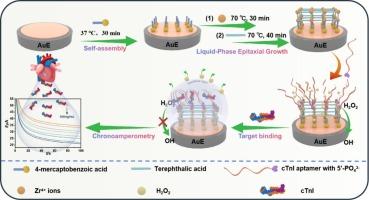Liquid-phase epitaxial grown UiO-66 as a bifunctional platform for electrochemical Aptasensing of cardiac troponin I
IF 4.5
2区 化学
Q1 BIOCHEMISTRY & MOLECULAR BIOLOGY
引用次数: 0
Abstract
The construction of multifunctional nanointerface bearing rich active site for aptamer immobilization and effective signal transformation is critical for the development of high-performance electrochemical aptasensor. Herein, a layer of p-mercaptobenzoic acid (p-MBA) was self-assembled on the surface of bare gold electrode (AuE), acting as a scalfod for the consequent liquid-phase epitaxial growth of Universitetet i Oslo-66 (UiO-66) metal-organic framework via immersion in zirconium ions (Zr4+) and p-terephthalic acid (PTA) ligand. Then, the UiO-66 was utilized as a bifunctional platform for immobilization of aptamer probe for cardiac troponin I (cTnI) and the electrochemical signal transformation as an electrocatalyst. Electrochemical experiments showed that UiO-66 has catalase-like properties for electrocatalytic reduction of H2O2, while when the aptamer interacts with cTnI to form a complex, the catalytic acttivity is inhibited. The catalytic currents in chronoamperometric measurements showed a good linear relationship with the negative logarithm of the target concentration in the range of 100 fg mL−1–100 ng mL−1, and the detection limit was 13 fg mL−1. The aptasensor has good selectivity for cTnI and can be used for the detection of cTnI in human serum samples.

液相外延生长UiO-66作为电化学偶联肌钙蛋白I的双功能平台
构建具有丰富活性位点的多功能纳米界面用于适配体的固定和有效的信号转换是开发高性能电化学适配体传感器的关键。本文将一层对巯基苯甲酸(p-MBA)自组装在裸金电极(AuE)表面,通过锆离子(Zr4+)和对对苯二甲酸(PTA)配体的浸泡,作为Universitetet i Oslo-66 (uuo -66)金属有机骨架的液相外延生长的“鱼鳞”。然后,利用UiO-66作为双功能平台,固定化了心肌肌钙蛋白I (cTnI)适体探针,并作为电催化剂进行了电化学信号转化。电化学实验表明,UiO-66具有类似过氧化氢酶的电催化还原H2O2的性质,而当适体与cTnI相互作用形成配合物时,催化活性受到抑制。在100 fg mL−1 ~ 100 ng mL−1范围内,计时安培测量的催化电流与靶浓度的负对数呈良好的线性关系,检出限为13 fg mL−1。该适体传感器对cTnI具有良好的选择性,可用于人血清样品中cTnI的检测。
本文章由计算机程序翻译,如有差异,请以英文原文为准。
求助全文
约1分钟内获得全文
求助全文
来源期刊

Bioelectrochemistry
生物-电化学
CiteScore
9.10
自引率
6.00%
发文量
238
审稿时长
38 days
期刊介绍:
An International Journal Devoted to Electrochemical Aspects of Biology and Biological Aspects of Electrochemistry
Bioelectrochemistry is an international journal devoted to electrochemical principles in biology and biological aspects of electrochemistry. It publishes experimental and theoretical papers dealing with the electrochemical aspects of:
• Electrified interfaces (electric double layers, adsorption, electron transfer, protein electrochemistry, basic principles of biosensors, biosensor interfaces and bio-nanosensor design and construction.
• Electric and magnetic field effects (field-dependent processes, field interactions with molecules, intramolecular field effects, sensory systems for electric and magnetic fields, molecular and cellular mechanisms)
• Bioenergetics and signal transduction (energy conversion, photosynthetic and visual membranes)
• Biomembranes and model membranes (thermodynamics and mechanics, membrane transport, electroporation, fusion and insertion)
• Electrochemical applications in medicine and biotechnology (drug delivery and gene transfer to cells and tissues, iontophoresis, skin electroporation, injury and repair).
• Organization and use of arrays in-vitro and in-vivo, including as part of feedback control.
• Electrochemical interrogation of biofilms as generated by microorganisms and tissue reaction associated with medical implants.
 求助内容:
求助内容: 应助结果提醒方式:
应助结果提醒方式:


